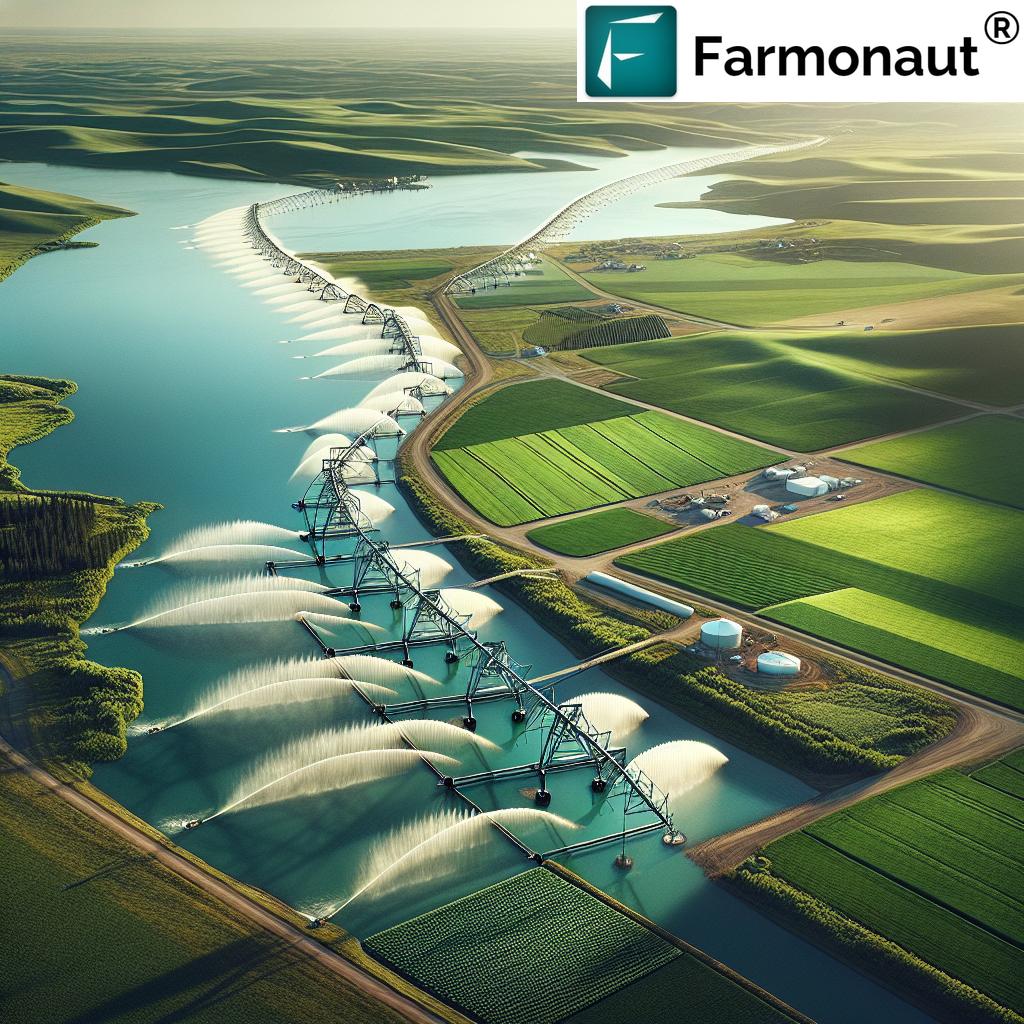“Lake Diefenbaker irrigation projects in Saskatchewan are projected to generate $5.9 billion in economic impact.”
Table of Contents
- Introduction: Lake Diefenbaker’s Untapped Promise
- The Significance of Irrigation in Saskatchewan and the Economic Impact
- Lake Diefenbaker Water Supply: The Province’s Lifeline
- Westside Irrigation Project: Transforming Saskatchewan’s Landscape
- Impact on Economic Growth, Jobs, and Related Industries
- Climate Resiliency in Agriculture & Drought Mitigation Strategies
- Boosting Agricultural Output and the Food Processing Industry in Saskatchewan
- Farmonaut’s Role in Supporting Precision Agriculture
- Projected Benefits: Lake Diefenbaker Irrigation Projects (Table)
- Addressing Challenges and The Path Forward
- FAQs: Irrigation in Saskatchewan, Lake Diefenbaker, and Agricultural Innovation
Irrigation in Saskatchewan: Unleashing Lake Diefenbaker’s $5.9 Billion Impact
The sun-drenched fields of Saskatchewan offer vast potential—not just for our provincial agricultural sector, but for the economic and environmental health of all Canadians. At the core of this promise is Lake Diefenbaker, an unparalleled water source whose transformative capacity is just beginning to be realized. From the public information session held in Elbow on April 22 to the sweeping economic analysis recently completed in 2024, it’s clear that irrigation projects like the Westside Irrigation Rehabilitation are poised to change the face of our province’s food, job, and water landscape for decades to come.
In this comprehensive guide, we’ll dive deep into the significance of irrigation in Saskatchewan, the pivotal role of Lake Diefenbaker water supply, details of the Westside irrigation project, job creation, regional and provincial economic impacts, food processing industry growth, and the future of sustainable, climate-resilient agriculture in Saskatchewan and Canada.
“Westside irrigation expansion could create over 2,500 new jobs, enhancing climate resiliency in Saskatchewan.”
The Significance of Irrigation in Saskatchewan and the Economic Impact
When we talk about irrigation in Saskatchewan, what’s truly at stake is the future prosperity and resilience of our province. Saskatchewan is globally recognized as one of the breadbaskets of Canada and, by extension, the world. However, with only a fraction of our arable land currently under irrigation, massive untapped potential remains.
- Presently, about 60% of Saskatchewan’s population relies on water from Lake Diefenbaker.
- Economic Analysis Completed in 2024—Irrigation projects linked to Diefenbaker are expected to increase Gross Domestic Product (GDP) by a reported $5.9 billion.
- This translates into the creation of over 30,000 person-years of employment and over 9,500 jobs during construction.
By purposefully developing projects like the Westside irrigation project and modernizing rehabilitation initiatives, our province can:
- Increase agricultural output and food security
- Boost local and provincial economic development
- Strengthen drought mitigation strategies and enhance climate resiliency in agriculture
- Create sustained, high-quality jobs
- Accelerate growth for Saskatchewan’s rapidly expanding food processing industry
Our commitment as a community—planners, farmers, policymakers, and technology innovators—ensures that these outcomes are not just possible, but within our collective reach.
Lake Diefenbaker Water Supply: The Province’s Lifeline
Situated in the heart of our province, Lake Diefenbaker is more than a scenic destination. It’s the largest untapped body of water in Saskatchewan, with enormous capacity to provide water for communities, industry, and agricultural producers throughout the region. Created in the 1960s through the damming of the South Saskatchewan and Qu’Appelle Rivers, Lake Diefenbaker’s:
- Surface area covers over 500km², making it one of the most significant bodies of freshwater in Canada
- Currently supplies water to around 60% of Saskatchewan’s population—from urban homes to irrigated farmland
- Holds the capacity to supply 300,000 people for 18 years from just one metre of water
- Supports extensive irrigation systems, municipal water supplies, and regional agricultural development
Yet, despite this magnitude, much of the lake remains under-utilized. Local producers and water managers, echoed in the public information session in Elbow, believe that we are only beginning to tap into this source’s true potential.
Westside Irrigation Project: Transforming Saskatchewan’s Landscape
The Westside Irrigation Rehabilitation Project stands as a generational investment in our province’s future. Discussed extensively at the Elbow public information session (April 22, Harbor Golf Community Center), this initiative is designed to unlock the full promise of the Lake Diefenbaker water supply for agricultural producers, communities, and new industries across Saskatchewan.
Project Highlights:
- Modernizes and expands existing infrastructure to deliver more reliable irrigation to thousands of hectares of prime farmland in the Elbow area and surrounding region.
- Backed by Water Security Agency, Ministry of Agriculture, and Irrigation Saskatchewan, the project’s vision is regional, but its benefits cascade across the province and Canada.
- Enables a major increase in food production, supports drought mitigation strategies, and fosters system-wide sustainability.
Institutional Support & Local Involvement
- The project is guided by input from public agency representatives and private irrigators on boards—ensuring community needs remain at the forefront.
- Stephanie Boyle, a local irrigator and board member, emceed the Elbow session.
- Input from executive director Leah Clark (Water Security Agency) and ministry officials highlight a collaborative, science-driven approach to development.
This collaborative structure is designed to ensure healthy lands, equitable water access, and smart agricultural expansion. As Clint Ringdal, a respected local farmer, shared during the event: “There’s capacity for us all to benefit.”
Impact on Economic Growth, Jobs, and Related Industries
One of the most exciting dimensions of the Westside irrigation project (and by extension, broader Lake Diefenbaker irrigation initiatives) is its explosive impact on the region’s economy. Here’s how the numbers break down, based on the 2024 economic analysis completed:
- $5.9 Billion GDP Boost: A massive increase in gross domestic product over the project lifecycle—fueling growth across Saskatchewan and Canada.
- Over 30,000 Person-Years of Employment: This equates to significant jobs created by irrigation projects—including more than 9,500 positions during the construction period and thousands more for ongoing operations, food processing, and related industries.
- 2,500+ Permanent New Jobs: From on-farm employment to technical specialists and food processing roles, these jobs are spread across rural and urban communities—a major win for regional development and community well-being.
- Increased Investments in Infrastructure and Services: Expansion of roads, storage, education, and health services, driven by population and economic growth derived from an invigorated agricultural sector.
How Does Irrigation Grow the Economy?
- Multiplier Effect in Agri-Processing: By providing reliable irrigation, we attract major investments in food processing industry growth, creating value-added products, export opportunities, and downstream employment.
- Rural Revitalization: With new jobs and community investment, smaller towns—like those near Elbow—enjoy increased stability and quality of life.
- Attracting Young People: The promise of meaningful, technical, and sustainable jobs helps curb rural depopulation.
Climate Resiliency in Agriculture & Drought Mitigation Strategies
As global weather becomes more unpredictable, the capacity of Saskatchewan’s agriculture sector—and indeed, all of Canada’s food growers—to adapt is paramount. Investment in irrigation rehabilitation projects such as these brings climate resiliency front and center by:
- Enabling precise drought mitigation strategies: Reliable water access ensures that producers can withstand longer dry periods without devastating crop losses, protecting livelihoods and food supply.
- Encouraging water conservation: Modern infrastructure, carbon footprinting, and data-driven practices—enabled by precision tools—reduce water waste, minimize environmental impact, and optimize productivity.
- Supporting adaptive agricultural practices: With better data, resources, and planning, Saskatchewan farmers can rotate crops, adjust planting, and employ soil health strategies that are responsive to changing climate conditions.
- Boosting resilience at the landscape scale: Communities connected to Lake Diefenbaker are better positioned to respond collectively to climate extremes—whether drought, floods, or severe storms.
This comprehensive approach makes Saskatchewan a Canadian leader in sustainable, climate-smart agriculture.
Boosting Agricultural Output and the Food Processing Industry in Saskatchewan
The connection between irrigation and provincial food processing industry growth is direct:
- Reliable irrigation: Enables two or even three high-quality harvests per season for many crops, which in turn increases agricultural output.
- Food processing industries: Benefit from a steady, high-quality supply of raw products, positioning Saskatchewan as a key supplier and exporter of agri-food products throughout Canada and globally.
- Value-Added Benefits: Growth in these sectors means more dollars stay in the region, bolstering the local economy and providing new, non-farm employment opportunities.
- Farm management technologies: large-scale farm management solutions, such as those offered by Farmonaut, empower agribusinesses to monitor, plan, and optimize irrigation and input decisions with real-time precision, reducing waste and maximizing profits.
A Sample of Industries Benefiting From Lake Diefenbaker Irrigation Expansion:
- Cereal and pulse crop production
- Potato and specialty crop processing
- Agri-food logistics, packaging, and transportation
- Trucking, fleet, and resource management industries (learn more)
- Equipment, construction, and engineering firms involved in building and maintaining irrigation infrastructure
Farmonaut’s Role in Supporting Precision Agriculture
As Saskatchewan and Canada move toward scalable sustainable agriculture, technology’s role becomes central. Farmonaut provides a cost-effective, data-rich platform designed to help farmers and decision-makers maximize irrigation efficiency, track climate impact, secure supply chains, and more. Here’s how our technologies complement projects like the Westside expansion:
- Satellite-Based Crop Health Monitoring: Delivers multispectral images and real-time vegetation health analytics, empowering producers to pinpoint irrigation needs and optimize fertilizer and water use, thereby reducing resource wastage.
- Jeevn AI Advisory System: Offers weather insights and farm management recommendations, improving yield prediction and risk mitigation.
- Blockchain-Based Product Traceability: Fosters transparency—consumers, food processors, and exporters can trace the entire journey of crops from field to table (read about blockchain traceability).
- Resource & Fleet Management: Ensures efficient use of machinery, smarter logistics, and reduced downtime—vital for food processing supply chains. (see fleet management use case)
- Carbon Footprinting: Provides detailed emissions data to support compliance and improvement in sustainable farming practices. (learn about carbon tracking)
- API and Integration: For large ag-enterprises and developers, Farmonaut’s API and Developer Docs open up enhanced possibilities for custom analytics, automation, and research at every scale.
Our mission is to keep precision agriculture affordable, accessible, and relevant to producers of every size—from individual Saskatchewan farmers to major agribusinesses and policymakers.
Projected Benefits: Lake Diefenbaker Irrigation Projects (Summary Table)
| Aspect | Estimated Value | Description/Notes |
|---|---|---|
| Economic Impact | $5.9 billion GDP increase | Provincial and regional boost over project lifecycle, driven by irrigation-enabled agricultural and food processing growth. |
| Job Creation | 30,000 person-years total; 9,500 during construction; 2,500+ permanent jobs | Ongoing and construction-phase positions in farming, ag-tech, logistics, food processing, and support industries. |
| Climate Resiliency | Estimated 20% increase in regional climate adaptation capacity | Direct support for drought mitigation, diversified crop resilience, and better risk management. |
| Water Supplied | Hundreds of millions of megaliters over 50 years | Serves 60%+ of Saskatchewan’s population, industrial, and agricultural needs; 1 meter supplies 300k people for 18 years. |
| Agricultural Output Increase | Projected 20-30%+ increase in irrigated crop yields | Supports multiple harvests and new value-added processing, stabilizing supply chains and food security. |
Addressing Challenges and The Path Forward
While the outlook for irrigation in Saskatchewan is extraordinary, pragmatic steps are essential to ensure long-term success:
Key Considerations
- Regulatory Oversight: Ongoing work by agencies such as the Water Security Agency and Ministry of Agriculture ensures water quality, access, and environmental stewardship, maintaining healthy lands for all stakeholders.
- Community Engagement: Public information sessions (like those in Elbow and Conquest) foster dialogue, ensuring that private irrigators, local residents, and Indigenous communities are partners, not bystanders, in development.
- Technology Adoption: Platform-based solutions, like Farmonaut’s crop and forest advisory services, help scale best practices, optimize inputs, and guarantee long-term viability of irrigation systems.
- Financial Accessibility: Smart financing and insurance solutions—supported by Farmonaut’s crop loan and insurance validation tools—make it easier for Saskatchewan producers to invest in innovation.
- Environmental Sustainability: Continuous monitoring via satellite and AI maximizes water-use efficiency and limits the footprint of large-scale irrigation.
By embracing these priorities, Saskatchewan can model a balanced path: economic growth, climate resiliency, and community well-being.
FAQs: Irrigation in Saskatchewan, Lake Diefenbaker, and Agricultural Innovation
What is the Westside irrigation project and why is it important?
The Westside irrigation project is a major infrastructure initiative aimed at expanding and modernizing irrigation networks fed by Lake Diefenbaker. It’s designed to unlock new agricultural, economic, and climate resilience benefits for Saskatchewan by supporting regional development, job creation, and food processing industry expansion.
How much of Saskatchewan’s water comes from Lake Diefenbaker?
Approximately 60% of Saskatchewan’s population currently relies on water supplied by Lake Diefenbaker for domestic, agricultural, and industrial purposes.
What is the estimated economic impact of the Lake Diefenbaker irrigation projects?
Recent economic analysis completed in 2024 estimates a $5.9 billion increase in GDP, the creation of 30,000+ person-years of employment, and major growth in the food processing industry and related sectors over a 50-year period.
How do irrigation and digital farm management technologies work together?
Advanced farm management platforms—like Farmonaut—use satellite data, AI, and blockchain to provide real-time insights on crop health, water needs, and environmental impacts. This allows Saskatchewan producers to make precise decisions on irrigation and input, boosting yields and minimizing waste for a more sustainable outcome.
What are drought mitigation strategies enabled by these projects?
By delivering reliable and timely water to agricultural lands, irrigation expansions help farmers survive prolonged dry periods, decrease crop failure risk, and stabilize food production, supporting broader provincial and Canadian food security goals.
Where can I learn more or get involved?
Visit diefenbakerirrigation.ca for in-depth project updates. For technology-powered irrigation and farm management, explore the Farmonaut platform.

















